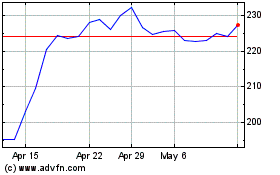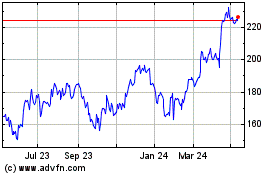Adidas to Close Sneaker Factory in the U.S., Move Production to Asia
November 11 2019 - 10:47AM
Dow Jones News
By Sara Germano
BERLIN -- Adidas AG plans to close its only sneaker factories in
the U.S. and Germany, shifting cutting-edge automated footwear
production to Asia and reversing an effort to make products closer
to shoppers in the West.
The German company, the world's second-largest athletic gear
maker by revenue after Nike Inc., said Monday it would move
technology developed at its so-called "Speedfactories" to two
suppliers in Vietnam and China.
The closure of the facilities in Ansbach, Germany, and suburban
Atlanta -- both opened within the past three years -- raises
questions about the feasibility of bringing manufacturing jobs back
to developed markets.
Adidas said the move would result in the "better utilization of
existing production capacity and more flexibility in product
design." A spokeswoman said the decision wasn't related to the
continuing trade dispute between the U.S. and China.
The closure of the two factories, which will cease production by
April, will together affect some 200 jobs.
The decision marks an abrupt shift in strategy for Adidas, which
has been gaining market share in the U.S. and has reported lagging
sales in its home market of Western Europe in recent months.
The Atlanta facility was announced in 2016 and began production
in late 2017. It was touted as part of a broader effort to be
closer to U.S. consumers, while innovating production processes
meant to cut time to market and competing with fast-fashion retail.
Earlier this year, Adidas promoted limited-edition shoes made at
the Georgia factory for the Atlanta-hosted Super Bowl.
Like industry leader Nike, Adidas sources the vast majority of
its footwear production from contracted manufacturers in Asia. Each
of the big three sportswear makers -- Nike, Adidas and Under Armour
Inc. -- have invested in or begun testing automated production
technology for footwear in recent years to diversify their
manufacturing strategy. Nike doesn't manufacture footwear in the
U.S., according to its manufacturing map. Under Armour in 2016
opened a facility for automated and 3-D product prototyping near
its headquarters in Baltimore.
Still, the volume of footwear produced at the Ansbach and
Atlanta factories was expected to be just a fraction of Adidas's
annual output. In 2016, the company anticipated some 500,000 pairs
of shoes would be made annually in Ansbach, and some 50,000 pairs
in Atlanta, each less than 1% of its 300 million pairs produced
overall.
Write to Sara Germano at sara.germano@wsj.com
(END) Dow Jones Newswires
November 11, 2019 10:32 ET (15:32 GMT)
Copyright (c) 2019 Dow Jones & Company, Inc.
Adidas (TG:ADS)
Historical Stock Chart
From Mar 2024 to Apr 2024

Adidas (TG:ADS)
Historical Stock Chart
From Apr 2023 to Apr 2024
